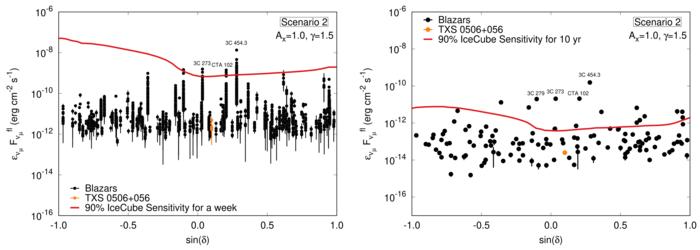Blazars belong to the family of active galactic nuclei called quasars. What differentiates them from quasars is that the flares ejected out of these active galactic nuclei are pointed toward the Earth. These flares contain high-energy cosmic rays which are released from the core of these galaxies as jets spanning many light years. Such cosmic rays can interact with photons to produce subatomic particles called neutrinos.

Credit: Kenji Yoshida from SIT, Japan
Blazars belong to the family of active galactic nuclei called quasars. What differentiates them from quasars is that the flares ejected out of these active galactic nuclei are pointed toward the Earth. These flares contain high-energy cosmic rays which are released from the core of these galaxies as jets spanning many light years. Such cosmic rays can interact with photons to produce subatomic particles called neutrinos.
Gamma-ray flares from blazars are thought to be the primary events behind neutrino detection in the sky. In 2017, the South Pole neutrino detector “IceCube” detected a high-energy neutrino event whose timings and positioning in the night sky coincided with the flare of a blazar called TXS 0506+056. Some scientists suggest that there could be a population of blazars whose flares are accompanied by high-energy neutrino emission. However, the relationship between blazar flaring activity and neutrino flux is yet to be properly understood.
In this regard, an international research team, led by Professor Kenji Yoshida from the Department of Electronic Information Systems at Shibaura Institute of Technology, Japan, has recently performed a comprehensive statistical analysis to understand the contribution of gamma-ray flares to neutrino emission. The team included Maria Petropoulou from the National and Kapodistrian University of Athens, Kohta Murase from The Pennsylvania State University, and Foteini Oikonomou from the Norwegian University of Science and Technology. Their paper was published in Volume 954, Number 2 of The Astrophysical Journal on September 6, 2023.
The researchers analyzed 145 blazars, 144 of them taken from the Fermi Large Area Telescope Monitored Source List and including TXS 0506+056, in this study. They first calculated a weekly average of the gamma-ray flux of the blazars and plotted their light curves. The team then derived the flare duty cycle (fraction of time spent in flaring state) and the corresponding energy fraction from these curves using a Bayesian blocks algorithm, a statistical method used to identify changes in a time series.
“We find that blazars with lower flare duty cycles and energy fractions are more numerous among our sample. Their flare duty cycles and energy fractions represent power law-like distributions, correlating strongly with each other. We found a significant difference between blazar subclasses for the flare duty cycles at the 5% significant level,” says Prof. Yoshida, highlighting the major results of their analysis.
The researchers evaluated the neutrino energy flux of each gamma-ray flare, using a general scaling relation for the neutrino and gamma-ray luminosities with a power law’s weighting exponent of 1.0–2.0, normalized to the quiescent gamma-ray or X-ray flux of each blazar. They also found that the gamma-ray flare distribution indicates that blazar neutrino emission may be dominated by flares for the weighting exponent >1.5. Furthermore, by comparing their neutrino predictions for each blazar for one-week and 10-year periods to the time-integrated IceCube sensitivity, the team placed upper limits on the contributions of the flares to the isotropic diffuse neutrino flux.
Prof. Yoshida remarks: “We hope that this study helps improve our understanding of the contribution of blazars to astrophysical neutrinos. Application of the present method to further observations might have the potential to contribute to the advancement of scientific knowledge of the origin of astrophysical neutrinos.”
Here’s hoping for a better understanding of these cosmic phenomena!
***
Reference
DOI: https://doi.org/10.3847/1538-4357/acea74
About Shibaura Institute of Technology (SIT), Japan
Shibaura Institute of Technology (SIT) is a private university with campuses in Tokyo and Saitama. Since the establishment of its predecessor, Tokyo Higher School of Industry and Commerce, in 1927, it has maintained “learning through practice” as its philosophy in the education of engineers. SIT was the only private science and engineering university selected for the Top Global University Project sponsored by the Ministry of Education, Culture, Sports, Science and Technology and will receive support from the ministry for 10 years starting from the 2014 academic year. Its motto, “Nurturing engineers who learn from society and contribute to society,” reflects its mission of fostering scientists and engineers who can contribute to the sustainable growth of the world by exposing their over 8,000 students to culturally diverse environments, where they learn to cope, collaborate, and relate with fellow students from around the world.
Website: https://www.shibaura-it.ac.jp/en/
About Professor Kenji Yoshida from SIT, Japan
Professor Kenji Yoshida is a Professor at the Department of Electronic Information Systems in Shibaura Institute of Technology, Japan. He completed his master’s and PhD degrees from the University of Tokyo. His research interests include high-energy astrophysics, astroparticle physics, and multimessenger astronomy. He has published more than 130 articles in the field of cosmic-ray physics and astrophysics, which have been cited over 3,500 times.
Funding Information
K.M. is supported by the NSF grant No. AST-1908689, No. AST-2108466, and No. AST-2108467, and KAKENHI No. 20H01901 and No. 20H05852. M.P. acknowledges support from the MERAC Fondation through the project THRILL and from the Hellenic Foundation for Research and Innovation (H.F.R.I.) under the “2nd call for H.F. R.I. Research Projects to support Faculty members and Researchers” through the grant No. 3013 (UNTRAPHOB).
Journal
The Astrophysical Journal
DOI
10.3847/1538-4357/acea74
Method of Research
Data/statistical analysis
Subject of Research
Not applicable
Article Title
Flare Duty Cycle of Gamma-Ray Blazars and Implications for High-Energy Neutrino Emissions
Article Publication Date
6-Sep-2023




